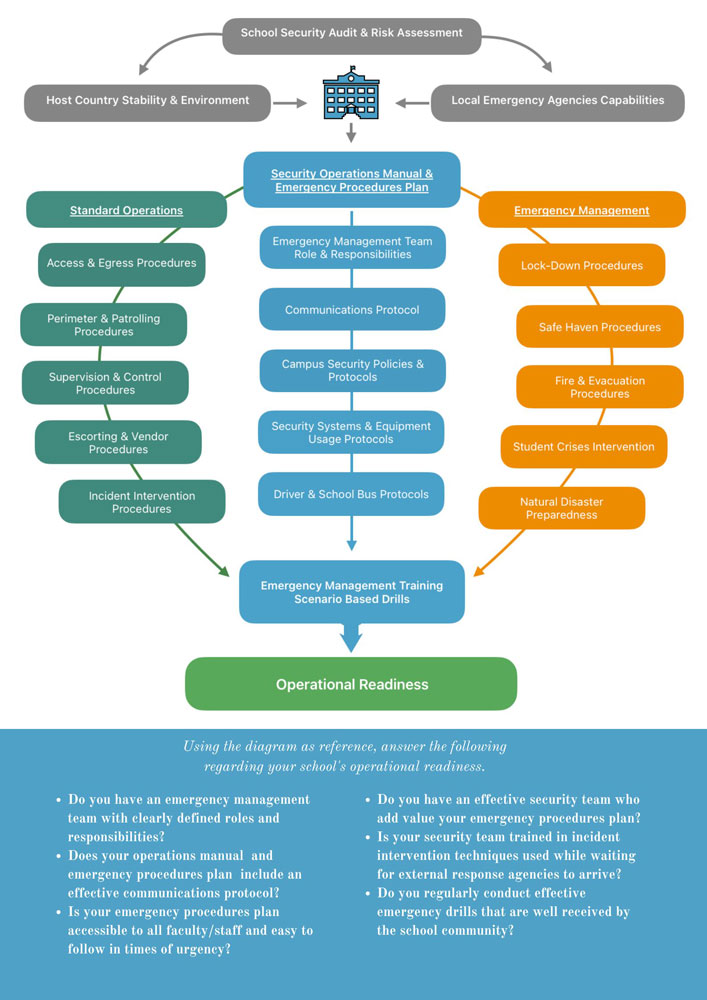
For an international Head of School starting a new position, school security is one of the many crucial aspects they would likely be reviewing. Often, they will have inherited existing security measures and procedures with standards of operational readiness that can vary dramatically. The Head of School has a duty of care to ensure that effective security measures exist and, therefore, takes ultimate responsibility for the safety of the school and its community.
In this context, standard of operational readiness refers to the functional state of the security and emergency measures in place. The primary purpose is to protect and keep the school community and structures safe. This would include daily standard operations and especially incident intervention and emergency procedures. When considering operational readiness, a Head of School will often find themselves influenced by certain factors that seem to form part of a common theme in international schools. These factors can significantly impact the assessment process for a leader/administrator when reviewing their school’s security profile.
With this in mind, the following pointers may be well worth considering:
1. A very common administrative structure for international schools is to have the security function assigned under an operations manager, or even a facilities/maintenance manager. For schools with fewer resources this makes financial sense; however, it should be noted that these managers often do not have the background, experience, or qualifications to take on security management of a school effectively. They usually already have a full plate of responsibilities in their primary roles, and this can lead to a challenge when trying to keep the school safe. Getting by on daily standard security measures is one thing, but professional depth is needed in preparation for unexpected incidents and emergency management planning.
2. Having a dedicated security/safety manager is, then, seemingly ideal, especially for bigger schools. As with the rest of the security team (in-house or contracted) this position is normally filled by a local-national employee. There are multiple and obvious benefits to this, but it should also be noted that this person may have no international security exposure or training. If they only have in-country systems and standards as a reference point, they cannot be expected to fully understand essential requirements in international school security, unless specifically trained to do so.
3. Operational readiness also refers to resources available in the form of security systems and equipment, including functioning standard operations and emergency procedure manuals. Professionalism and training of the security team is pivotal to their success, as is effective supervision, quality control, and leadership. Along with an appointed security manager, this all takes time and costs money to implement effectively.
4. When allocating resources to security, school administrators often look at the equation of probability and cost versus impact. The temptation to allocate less resources to a low-probability scenario is always there; however, the cost of a high-impact, worst-case scenario, will always outweigh the costs of maintaining adequate security systems. Likely, these would need to be put in place after a serious incident anyway.
5. Finally, the age-old invulnerability illusion that “it will never happen here or to me” is seemingly still quite a tempting or convenient approach when it comes to implementing security measures, even if unwittingly so. Unfortunately, an abundance of media evidence shows that falling prey to this myth, and the associated complacency around emergency management, can have dramatic and tragic consequences for a school.
If any of the above pointers sound familiar or are cause for doubt in a school’s current security and operational readiness, the diagram below could be used as a checklist model for what should be in place at most schools. Having each aspect of the model in place is a solid foundation, but effective implementation will require resources, time, and planning on the part of the school administration.

Stay Safe!
Mike Mills is a security consultant, trainer, and contractor. He was Head of Security for the American International School of Lusaka (AISL) in Zambia and then a Security Manager for Providence Medical Group in Spokane, Washington. His related experience began in the military as a young paratrooper, where as a non-commissioned officer received operational service awards and saw active duty during the South African/Cuban conflict in Angola. He went on to join and serve in the Hertfordshire Constabulary, United Kingdom until shortly after the start of Operation Iraqi Freedom. He then entered the world of security contracting, and initially deployed as team leader on Personal Security Detachment (PSD) assignments in Iraq and then Afghanistan, which included US Department of Defense and USAID contracts respectively. Mike then took on consultant and trainer contracts for Hostile Environment Awareness Training (HEAT) provided to European Union election observers deploying on international election observation tasks. He also deployed as Assistant Security and then Security Manager on contracts for the European Union election observation missions in Afghanistan, Lebanon, and Myanmar. In addition to a list of military courses and qualifications, Mike held a South African commercial pilot license and flew helicopter charter flights between security contracts. He has a Business and Technology Education Council (BTEC) Diploma in Special Security Management and qualified on the US Diplomatic Security Service - Federal Active Shooter Response Program. Mike´s wife is an international school Principal, and they are both deeply invested in school security and student safety.